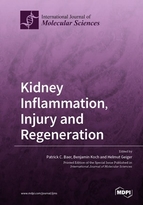Kidney Inflammation, Injury and Regeneration
A special issue of International Journal of Molecular Sciences (ISSN 1422-0067). This special issue belongs to the section "Molecular Pathology, Diagnostics, and Therapeutics".
Deadline for manuscript submissions: closed (29 November 2019) | Viewed by 195049
Special Issue Editors
Interests: mesenchymal stromal/stem cells; acute kidney injury; renal tubular cells; adipose tissue; renal regeneration; extracellular vesicles
Special Issues, Collections and Topics in MDPI journals
Interests: renal diseases; acute kidney injury; chronic kidney; hypertension; dialysis; renal transplantation; renal regeneration
Special Issues, Collections and Topics in MDPI journals
Interests: transcriptomics in acute and chronic kidney injury; novel blood filtration devices in viral and bacterial sepsis; in vitro models of viral and bacterial sepsis; donor-specific antibodies in renal transplantation; extracellular vesicles; renal regeneration
Special Issues, Collections and Topics in MDPI journals
Special Issue Information
Dear Colleagues,
Acute kidney injury (AKI) is still associated with high morbidity and mortality incidence rates, and also bears an elevated risk of chronic kidney disease in the sequel. Whereas the kidney has a remarkable capacity for regeneration after injury and may recover completely depending on the type of renal lesions, the options for clinical intervention are restricted to fluid management and extracorporeal kidney support. The development of novel therapies to prevent AKI, to improve renal regeneration capacity after AKI and to preserve renal function—in both the short- and long-term—is urgently needed.
This Special Issue will include papers investigating the pathological mechanisms of renal inflammation and AKI, and diagnostics using new biomarkers. Furthermore, experimental in vitro and in vivo studies and clinical studies examining potential new approaches to attenuate kidney dysfunction are welcome.
This Special Issue welcomes original research and review papers. Potential topics include, but are not limited to, the following:
- Molecular mechanisms of kidney inflammation and epithelial cell injury
- Acute kidney injury (AKI) – Pathological mechanisms and new biomarkers
- Kidney inflammation and injury: Transcriptomics and proteomics
- In vitro models simulating tubular inflammation, injury and regeneration
- In vivo AKI models
- Investigations to preserve renal function using stem cells or their derivates
Dr. med. Benjamin Koch
Prof. Dr. med. Helmut Geiger
Prof. Dr. phil. nat. Patrick C. Baer
Guest Editor
Manuscript Submission Information
Manuscripts should be submitted online at www.mdpi.com by registering and logging in to this website. Once you are registered, click here to go to the submission form. Manuscripts can be submitted until the deadline. All submissions that pass pre-check are peer-reviewed. Accepted papers will be published continuously in the journal (as soon as accepted) and will be listed together on the special issue website. Research articles, review articles as well as short communications are invited. For planned papers, a title and short abstract (about 100 words) can be sent to the Editorial Office for announcement on this website.
Submitted manuscripts should not have been published previously, nor be under consideration for publication elsewhere (except conference proceedings papers). All manuscripts are thoroughly refereed through a single-blind peer-review process. A guide for authors and other relevant information for submission of manuscripts is available on the Instructions for Authors page. International Journal of Molecular Sciences is an international peer-reviewed open access semimonthly journal published by MDPI.
Please visit the Instructions for Authors page before submitting a manuscript. There is an Article Processing Charge (APC) for publication in this open access journal. For details about the APC please see here. Submitted papers should be well formatted and use good English. Authors may use MDPI's English editing service prior to publication or during author revisions.
Keywords
- Renal inflammation
- Acute kidney injury
- Pathological mechanisms
- Renal tubular epithelial cells
- Biomarkers
- Transcriptomics
- Proteomics
- Epithelial recovery
- Organ regeneration
- Tissue engineering
- Regenerative medicine







